Levittown: Blessing or Curse?
After W.W.II, American families were yearning to have affordable houses. For over 15 years, there had been a severe shortage of housing developments. The Great Depression and W.W.II slowed the expansion of home building. After the war, returning veterans found themselves trapped in small urban dwellings with little room to raise a family. William J. Levitt was well aware of this housing shortage and made it his personal goal to create housing developments to meet the demands of America's growing housing needs. During the war, Levitt was responsible for mass producing housing units for the Navy. Levitt decided to use the same ideas he applied to housing development during the war and use it to mass produce houses on the outskirts of America's great cities. Levittown communities were built on Long Island, Bucks County, Pennsylvania, and Willingboro, New Jersey. In the 1950s, and even till this day, the communities that Levitt built epitomize mass-produced suburban communities. However, many believe that Levitt's communities were a blessing and helped many young families achieve the America Dream. Read the following excepts about Levittown and decide on your own whether these communities were a blessing or a curse upon the American landscape.
Pro
"The veteran needed a roof over his head instead of giving him just a roof we gave him certain amenities," Levitt explains. "We divided it into sections and we put down schools, swimming pools, and a village green and necessity shopping centers, athletic fields, Little League diamonds. We wanted community living" (Rosenbaum 385).
"Levittown houses were social creations more than architectural ones-- they turned the single detached single-family house from a distant dread to a real possibility for thousands of middle class American families" (Halberstam 132).
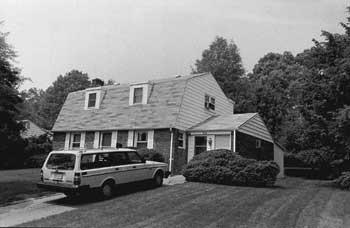
(Photo courtesy of http://tigger.uic.edu/~pbhales/Levittown/oldindex.html)
"But to drive through the place today is to experience a strange and unexpected transformation. None of the houses looks like any other house. Nor like any of the blank faces in the aerial photographs. Almost every single one of them has been added on to, extended, built out, remodeled to the max. The roofs have developed so many dormers it seems like they've grown dormers on dormers. Fronts have sprouted pergolas and porches, roof lines have been raised, pitched, expanded, corniced, and cupolaed. Sides have been carported, breezewayed, broken out, re-covered in redwood, sided in cedar shake, disguised in brick and fieldstone, transformed into ranches, splanches, colonials, and California ramblers. And those once-pathetic saplings have grown and flourished into fifty thousand shade trees spreading and merging, casting cozy covering of shadows and privacy over the rococo renovations" (Rosenbaum 388).
"The basic Levitt Cape Cod sold for $7,990; later, an expanded ranch-style house sold for $9,500." (Halberstam 135).
"The were no down payment, no closing costs, and no secret extras. Veterans who signed up for the first Levitt houses had to put down a one-hundred-dollar deposit, which they eventually got back" (Halberstam 139).
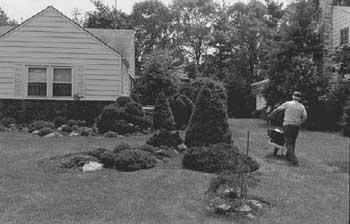
(Photo courtesy of http://tigger.uic.edu/~pbhales/Levittown/oldindex.html)
"A similar individuating transformation has taken place in the interiors of Levittown homes. In order to inspect some interiors, a woman friend and I posed as a soon-to-be-married couple looking for our first home. The only word to describe the interiors we saw is Dickensian. Like the intricately carved-out, compartmented, cabineted nautical interiors in Copperfield, Dombey, and Drood, the interiors of Levittown-- every square inch of them-- have been hollowed out, built in, latched, and sprung; rooms have been divided, opened out, closed off, and redivided, realigned, and redefined. Nothing has remained the same, nor do any two interiors resemble each other or the original" (Rosenbaum 388).
"This is mine. This house will look like me, this house sings of my spirit" (Rosenbaum 388).
"Maybe because they all started out looking so much the same . . . that's why they're trying so hard to be different" (Rosenbaum 388).
"And so we can look at the Levittown experience as an exact metaphor for the theory of American individualism. Those identical blank-faced Cape Cod pods all created equal, read to be inhabited, invigorated, individuated by democratic, undictated-to expressions of free will. We can look at Levittown as an almost perfect laboratory demonstration of the inexorable workings of the American individualist impulse" (Rosenbaum 388).
Quotes were taken from the following sources: Halberstam, David. The Fifties. New York: Fawcett Columbine., 1994. Rosenbaum, Ron. "The House that Levitt Built." Esquire December 1983: 378-391.
Con
"Building is being revolutionized by assembly-line construction with standardized materials. Geography is being upset by the movement and growth of mammoth new facilities for making aluminum, steel, power, atomic weapons" (Kimball 38).
"Starting from scratch, the Levitts will have converted eight square miles of open farm country into a densely populated community of 70,000. Paved streets, sewer lines, school sites, baseball diamonds, shopping center, parking lots, new railroad station, factory sidings, churches, trunk arteries, newspapers, garden clubs, swimming pools, doctors, dentists and town hall--all conceived in advance, all previously planned in one of the most colossal acts ever of mortal creation" (Kimball 39).
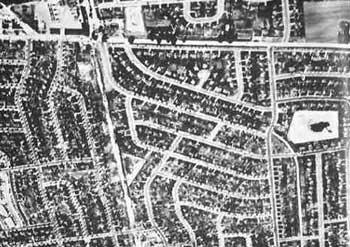
"The Levitts and their managers knew they had to change the essential philosophy of home building in order to met their deadlines. They analyzed the construction process and broke it down into basic components. There were, they figured out, twenty-seven separate steps, so they would train twenty-seven separate teams--- each team would specialize in one step ... for it demanded less talented workers" (Halberstam133 ).
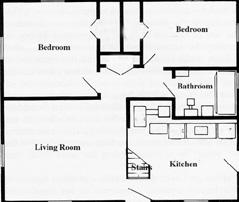
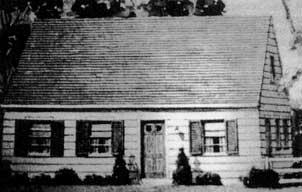
Photos courtesy of http://tigger.uic.edu/~pbhales/Levittown/building.html)
"Mass production methods right on the building site (Levitt carpenters never touch a hand saw; paint speckled in two colors comes out of one spray gun) make the Levitt price feasible. But they also defined the massive contours of a rather formidable looking city" (Kimball 40).
"By July 1948 they were building 180 houses a week or, in effect, finishing thirty-six houses a day. It was, Bill Levitt noted, like clockwork: 'Eighteen houses completed on the shift from 8 to noon, and 18 more houses finished on the shift from 12:20 from 4:30" (Halberstam 137).
"The first Levitt house could not have been simpler. It had four and a half rooms and was designed with a young family in mind. The lots were 60 by 100 feet, and bill Levitt was proud of the fact the house took up only 12 percent of the lot .... The most critical lesson the had learned in Norfolk was the necessity of forgoing the basement--the most difficult and complicated part of a house-- for a slab foundation" (Halberstam 135).
"Levittown, he [critic Lewis Mumford] implied, represented the worst vision of the American future: bland people in bland houses leading bland lives. The houses were physically similar, theorized Mumford, so the people inside must be equally similar; an entire community was being made from a cookie cutter .... a multitude of uniform, unidentifiable houses, lined up inflexibly, at uniform distances on uniform roads, in a treeless command waste, inhabited by people of the same class, the same incomes, the same age group, witnessing the same television performances, eating the same tasteless prefabricated foods, from the same freezers" (Halberstam 141).
"Late commuter, last among the identical rows of houses along identical street blocks, sometimes reported a sense of panic like bewildered children suddenly turned loose in a house of mirrors. 'I got lost there myself looking for street names I never heard of,' Bill Levitt recalls. When the lady of the house hung out the wash, the awesome result was 17,500 pairs of shorts flapping in 17,500 backyards" (Kimball 40).
"In the struggle against monotony the same floor plan has been enclosed by four different types of exteriors, painted in seven varieties of color-- so that your shape of Levittown house occurs in the same color only once every twenty-eight times. Streets are curved gently for further esthetic effect, and to slow down auto traffic" (Kimball 41).
Halberstam, David. The Fifties. New York: Fawcett Columbine., 1994.
Rosenbaum, Ron. "The House that Levitt Built." Esquire December 1983: 378-391.
Questions
- How were the Leviitowns designed? What system of development did Bill Levitt employ? Cite specific examples.
- Identify 3 criticisms of Levittown?
- Identify 3 positive aspect of Levittown?
- Do you believe that the Levittowns represent the America dream and spirit or do they represent a sociological nightmare?
- Compare the similarities and differences to the construction and design of Levittown to your community?
Using information from the quotes above and your own thoughts/beliefs assess the validity of the following statement by Winston Churchill: "We shape our dwellings, and then our dwellings shape us.